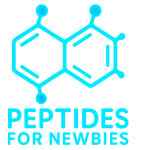Peptide Half-Life: A Simple Guide to Dosing & Efficacy
In peptide therapy, one of the most important concepts is the half-life (t1/2) – the time it takes for the concentration of a peptide in the body to fall by half. Half-life determines how often a peptide is given, how long it works, and how steady the results feel over time. Before we dive in with some examples, here are some key terms to help take your research to the next level:
- Steady state: an equilibrium where the peptide concentration lost between doses is equal to the next dose.
- Time to steady state: duration required for the concentration of a peptide in a body to reach a stable, predictable level once a dosing regimen is started. Mainly applies to long-acting peptides.
- Half-life: how fast a peptide leaves circulation.
- Onset of action: how quickly the peptide effect appears.
- Duration of action: how long the effect lasts, which may outlast the half-life. Such as Sermorelin causing elevated IGF-1 levels for hours even though Sermorelin’s half-life is ~6-12 minutes. Not always known, but if available, this could be very useful information in your research.
Why Half-Life Matters
Dosing schedule
- Short half-life = more frequent dosing.
- Long half-life = less frequent dosing.
Type of effect
- Short-acting peptides mimic natural pulses.
- Long-acting peptides maintain steady receptor engagement.
Steady state and safety
- With repeated dosing, levels build up and plateau at a stable level – known as steady state – usually reached after 4–5 half-lives.
Practical Example: Tirzepatide’s Half-Life and Accumulation
- Half-life: ~5 days (subcutaneous)
- Typical start: 2.5 mg once weekly
After 7 days, about 38% of a dose remains. Add a new injection and levels climb until the amount leaving each week equals the amount added. That balance is steady state, usually reached after about a month.
Step-through (2.5 mg once weekly):
- Week 1: Inject 2.5 mg.
- Week 2: ~0.95 mg remains. Add 2.5 → ~3.45 mg.
- Week 3: ~1.31 mg remains. Add 2.5 → ~3.81 mg.
- Week 4: ~1.45 mg remains. Add 2.5 → ~3.95 mg.
Alternative Example: Split Dosing
Instead of 2.5 mg once weekly, consider 1.25 mg twice weekly (every 3.5 days).
Walk-through (steady-state build):
- Day 0: Inject 1.25 mg.
- Day 3.5: ~0.77 mg remains. Add 1.25 → ~2.02 mg.
- Day 7: ~1.25 mg remains. Add 1.25 → ~2.50 mg.
- Day 10.5: ~1.25 mg remains. Add 1.25 → ~2.50 mg.
- Day 14: ~1.55 mg remains. Add 1.25 → ~2.80 mg.
- Day 17.5: ~1.55 mg remains. Add 1.25 → ~2.80 mg.
- Day 21: ~1.55 mg remains. Add 1.25 → ~2.80 mg.
By week 3–4, levels bounce between ~2.5 and ~2.8 mg.
Key takeaway:
- Weekly dosing: steadies around ~4.0 mg, but with higher peaks and lower troughs.
- Split dosing: steadies around ~2.5–2.8 mg, flatter and steadier.
Same weekly total, different pattern of exposure.
Why Half-Life Values Can Differ
You may notice the same peptide listed as “~5–6 days.” That’s normal. Half-life naturally varies because of:
- Different people: age, weight, and metabolism all change clearance rates.
- Study design: some trials measure longer or use more sensitive tests.
- Math models: researchers use different ways of fitting the data.
- Formulation details: stabilizers and excipients can alter absorption slightly.
The bottom line: half-life is always an approximation, and quoting a range is more accurate than one fixed number.
Reference Half-Life Guide (SC or IM unless noted)
Long-Acting (days)
- CJC-1295 w/DAC: 5.8–8.1 days
- Semaglutide: ~7 days
- Tirzepatide: ~5 days
- Retatrutide: ~6 days
- Cagrilintide: ~6–8 days
- MK-677 (oral): ~24 h
Intermediate (hours)
- Ipamorelin: ~2 h
- GHRP-6: ~2–3 h
- Hexarelin: ~55–70 min
- Thymosin Alpha-1: ~2 h
- Thymosin Beta-4 / TB-500 fragment: ~1–2 h (limited data)
- IGF-1 LR3: ~20–30 h
- PT-141: ~2.7 h
- HCG: ~31–56 h
- Glutathione: ~10–15 min
- SS-31: ~3–4 h
Short (minutes)
- CJC-1295 no DAC (Mod GRF-1-29): ~30 min
- Tesamorelin: ~26–38 min
- Sermorelin: ~6–12 min
- GHRP-2: ~30 min
- DSIP: ~7–8 min
- Epitalon (Epithalon): ~20 min (reported)
- Oxytocin (SC/IM): ~10–15 min
- Gonadorelin: ~10–40 min
- VIP: ~1–2 min
- GLP-2 (native): ~5–7 min
- Kisspeptin-10: ~4 min
Not Well Characterized in Humans (Often only animal or early research data)
- 5-Amino-1MQ
- AOD-9604 (animal IV ~3 min)
- ARA-290 (~20 min SC, limited reports)
- BPC-157 (<30 min in animals; human PK unknown)
- Cerebrolysin (mixture, no single half-life)
- Dihexa (preclinical)
- FOXO4-DRI
- GHK-Cu: ~30–60 min (reported)
- KPV
- LL-37: ~1 h (preclinical)
- Melanotan I: peptide short; implant releases over ~30 days
- Melanotan II: ~2–4 h (not well defined in humans)
- MGF: very short; PEG-MGF extends it
- MOTS-c (human not published)
- NAD+ (not a peptide; minutes to ~1 h depending on tissue)
- PE 22-28
- Pinealon
- Selank (intranasal not standardized)
- Thymalin (mixture)
